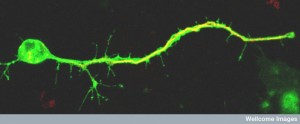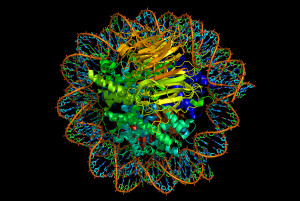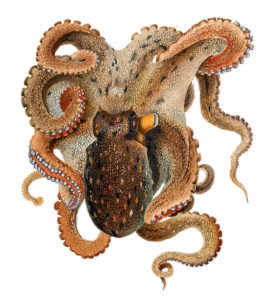 The octopus has advanced intelligence despite 500 million years of separate evolution from mammals, birds, insects and reptiles. Octopus ancestors are, perhaps, the first intelligent beings on Earth. Recent research is beginning to describe their very unusual talents, behavior and brain, as well as their unique genetic makeup. The fact that such an intelligent creature has no bones or spine has upended theories of animal intelligence.
The octopus has advanced intelligence despite 500 million years of separate evolution from mammals, birds, insects and reptiles. Octopus ancestors are, perhaps, the first intelligent beings on Earth. Recent research is beginning to describe their very unusual talents, behavior and brain, as well as their unique genetic makeup. The fact that such an intelligent creature has no bones or spine has upended theories of animal intelligence.
This post will describe recent research about their unique brain and its similarities and differences from humans. It shows a unique genetic expansion of genes that, somewhat differently, built the human brain. Both brains have different building blocks and molecular signaling cascades but similar hierarchical structure to analyze data.
Octopus Unique Intelligent Behavior
Octopuses are masters of getting through mazes and can solve advanced problems. They spread cultural information, mimic others and communicate using colors, patterns and flashing. They pick up coconut shell halves, carry them along and if threatened, flip them over their head to conceal themselves. Before their discovery of coconuts, they used shells. With two shells, they see through a small opening slit between the two halves.
 They can change their appearance with camouflage, so they can hide in plain sight near a wide variety of plants and corral, as well as mimicking other creatures. This is important for protection since they don’t have teeth or claws. They have advanced spatial learning, navigational abilities and use creative predatory techniques. Octopuses manipulate objects as well as the human hand and can escape from almost anything. They learn and can solve complex problems like crows.
They can change their appearance with camouflage, so they can hide in plain sight near a wide variety of plants and corral, as well as mimicking other creatures. This is important for protection since they don’t have teeth or claws. They have advanced spatial learning, navigational abilities and use creative predatory techniques. Octopuses manipulate objects as well as the human hand and can escape from almost anything. They learn and can solve complex problems like crows.
Octopuses adapt to being captured in several days, unlike many other animals. The change is from a fearful animal to almost pet like—friendly and very alert about all that is occurring nearby. Octopuses respond rapidly to rewards and are extremely curious and responsive. They focus on any new object they see. When experimental probes are done in the nervous system, they rapidly recover and regenerate missing tissue. Octopuses are extremely and rapidly adaptive. They learn by watching others, do tricks with visual discrimination and they remember exactly for weeks. Their brain uses the same circuits for social learning and for other memory.
The octopus has very unusual abilities that make it unique among intelligent animals, such as camouflage and control and regeneration of eight flexible arms, each with thousands of suckers. Two of their relatives—squid and cuttlefish—are, also, unusually intelligent. Their eyes are like a camera with a lens, iris and retina. They have large unique brains and closed blood circulation with three hearts.
Recent Octopus Genetic Information Alters Theory of the Evolution of Intelligence
 New research shows the unique evolutionary path octopus traveled to great intelligence. A previous post showed the unique brain structures for the crow. Both the crow and the octopus separated from mammals in evolution hundreds of millions of years ago and took very separate paths to building brains. Crows evolved through a line that led to dinosaurs; the octopus came from a line that separated in the Cambrian to become encephalopods. Mammals grew from amphibians, and reptiles and built their own brains. A previous post showed that lizards are very intelligent also with different brains. Insects, with tiny brains are, also, extremely intelligent (see posts on bees, ants and termites). Despite having no common ancestor all of these lines developed very high intelligence. Brains developed completely independently, but have some surprising similarities in neuronal organization.
New research shows the unique evolutionary path octopus traveled to great intelligence. A previous post showed the unique brain structures for the crow. Both the crow and the octopus separated from mammals in evolution hundreds of millions of years ago and took very separate paths to building brains. Crows evolved through a line that led to dinosaurs; the octopus came from a line that separated in the Cambrian to become encephalopods. Mammals grew from amphibians, and reptiles and built their own brains. A previous post showed that lizards are very intelligent also with different brains. Insects, with tiny brains are, also, extremely intelligent (see posts on bees, ants and termites). Despite having no common ancestor all of these lines developed very high intelligence. Brains developed completely independently, but have some surprising similarities in neuronal organization.
In fact, although all these brains show different building blocks, chemical pathways and brain structures; they have similar hierarchical organization.
Octopus History
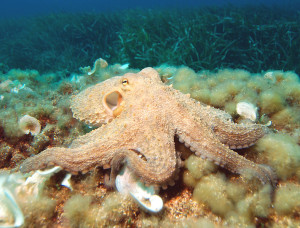
The encephalopods separated from the ancestors of intelligent creatures 500 million years ago. They separated from the line of nautilus and arose as predators 400 million years ago. Nautilus had precursors of neurons very early; nautilus, also, has advanced memory, learning and spatial awareness, but less than the octopus. Very intelligent squid separated from the octopus in evolution 270 million years ago. The octopus rapidly evolved large brains 65 million years ago while competing with fish and reptiles.
Advanced cognitive traits started in the octopus hundreds of million years ago, much earlier than mammals. The octopus brain design is like snails with the gut in the center and the brain around it. Others in the larger octopus family (molluscs) have chains of nervous ganglia. But in the encephalopods, they formed a central nervous system. Surprisingly, learning and memory in the octopus are similar to mammals and both have similar neuroplasticity.
Advanced motor and sensory capacities, rapid learning and memory, very good vision, and efficient flexible arms allowed competition with fish, amphibians and reptiles, even without claws or other weapons. It was their unique talents that allowed them to compete with dangerous powerful creatures. They developed camera eyes similar to vertebrates, but which operate differently. They developed very complex mechanisms for instantaneous camouflage.
The Octopus Brain
 The octopus brain is similar in relative weight with vertebrates—larger than reptiles and fish, smaller than mammals and birds. It has 500 million neurons, which is similar to a dog, six times more than a mouse.
The octopus brain is similar in relative weight with vertebrates—larger than reptiles and fish, smaller than mammals and birds. It has 500 million neurons, which is similar to a dog, six times more than a mouse.
The octopus brain is split into two halves and then into many lobes with particular functions. These lobes are folded, which increases the surface areas and connections. Some regions have very small neurons where large numbers can be packed into a small compartment. Also, the distance between them is very short, which increases processing speeds.
The Vertical Lobe (VL) is the seat of learning and memory and is organized like the human hippocampus with many sensory inputs at right angles to the small neurons that process the information. These have a large amount of connections, which converges in fewer outputs (the peduncle) that is like the cerebellum in controlling movement. Like the human cerebellum, they have many thin fibers lined up together. Synapses have less proteins and no myelin.
The brain is divided into three parts, each with a hierarchy. The central brain, surrounded by cartilage, has 50 million neurons and surrounds the gut. The vision brain (with 150 million neurons) and the eight arm brains (with a total of 300 million distributed neurons) are outside of the central nervous system.
The CNS looks slightly like the mammal brain with 40 lobes each consisting of outer gray matter and inner white matter. Studies of the human brain now find hubs that are highly locally connected and then globally between hubs (using myelin for rapid long distance communication). The octopus brain occurred by shortening connections of ganglia (other cephalopod structures) to speed up computation with no myelin.
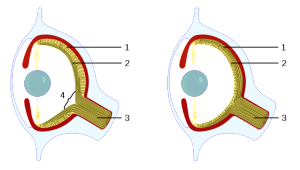
Octopus and Vertebrate
The octopus optic lobe has three cortical layers like the human retina. It is striking that the way octopus process light is very different yet the regions of synthesis of data are similar. Octopus light receptor cells increase membrane potential, while humans decrease potential (hyperpolarize). The molecular cascades are quite different.
One region looks like the human cerebellum with granular cells and thin parallel fibers. This region behaves like a cerebellum, also, taking sensory input of vision and gravitation while controlling motor movement. The hierarchy is similar in the integration of vision and gravitation timing—eye-motor coordination. The vertical lobe (VL) in the brain’s center looks like the hippocampus both in architecture and in function for memory and learning.
A possible conclusion is that it is not the specific building blocks but the organization that leads to or allows the expression of intelligence.
Octopus Lobes for Learning
 The octopus brain is even more specific than mammals in the location of learning and memory—the ventral lobe or VL. When the VL is removed, octopus behaved quite normally. Stimulation of the VL produced no movements. The VL deficits are only in memory and learning—it doesn’t remember when shocks will occur in an experiment. The VL is important for learning from observation of others and all long-term memory. The VP has two layers with glutamate transmission and then acetylcholine. Both layers have short and long neuroplasticity.
The octopus brain is even more specific than mammals in the location of learning and memory—the ventral lobe or VL. When the VL is removed, octopus behaved quite normally. Stimulation of the VL produced no movements. The VL deficits are only in memory and learning—it doesn’t remember when shocks will occur in an experiment. The VL is important for learning from observation of others and all long-term memory. The VP has two layers with glutamate transmission and then acetylcholine. Both layers have short and long neuroplasticity.
The VL has 2 types of mono-polar neurons, where 25 million very small interneurons connect with 65,000 very large neurons. Only the large neurons send axons from the VL. There are only two inputs to the VL with 1.8 million axons from the medial superior frontal (MSF) lobe. MSF integrates sensory information like the human thalamus, and once integrated, data goes to the VL in a special circuit between the VL grey and white matter. Just like the hippocampus (pyramidal versus Shaffer cells), the VL tracts are perpendicular to the MSF circuit. These MSF connect with the 25 million VL interneurons.
The VL (with 25 million neurons) and the sub frontal lobe (with 5 million neurons) comprise most of the CNS (total 40 million). These contain the smallest neurons in the brain, making the large number of neurons very close and efficient. The VL, also, has folded gyri like the human brain making the surface area greater. These two regions are quite different from all other brain locations.
Electro Physiological Studies
Electric properties of VL neurons are surprisingly like mammal brains. The cell bodies are not excited. The axon and dendrite connections are similar. The region that integrates information and then fires an action potential is similar while not exactly the same.
The VL shows long-term potentiation neuroplasticity. The responses are similar to glutamate AMPA responses in humans. Other neurotransmitters are similar (such as kynurenate). They are not similar to the human NMDA mechanism. However, NMDA currents are found in the chromatophore (discussed later as the mechanism for camouflage). The LTP is similar to the hippocampus CA3 region. Serotonin is involved in short-term neuroplasticity in the VL. Nitric oxide is involved in memory and learning. Acetylcholine is involved in visual learning.
The types of neurotransmitters, cell structure, and membranes are different, but the network hierarchy, wiring and neuroplasticity are similar.
Unique Octopus Genetics Build A Brain
Octopuses have the most genes of any invertebrate (2.7 billion bases) and more protein coding genes (33,000) than humans (20,000). Their genome is unusual and confusing. This week it was mapped for the first time in detail.
It is six times larger than any other invertebrate and has 28 chromosomes (double other invertebrates). 45% of octopus genome consists of repetitive elements with jumping genes. The great expansion caused by jumping genes occurred at 25 and 50 million years ago. Very telling is the fact that octopus has many gene networks (called protocadherin genes discussed below) that are involved in mammals’ complex brain networks, which occurred despite hundreds of million years of separation in evolution. These allow great capacity to process information.
The large recent genetic study demonstrates very rapid expansion of important gene families intermittently over millions of years, but not for the reasons that were expected. They found no whole genome duplications, which was previously assumed.
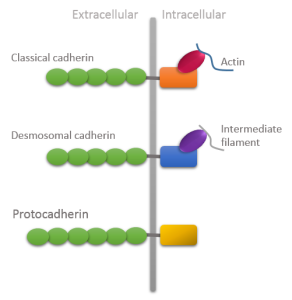
One very important gene family in mammals that was expanded in octopuses in unique new ways is the protocadherins that are very significant for brain development. A second expansion occurred in the genes that control C2Hs zinc-finger factors, significant for for transcription. Others genes that were greatly expanded are interleukin 17 like genes, and G protein coupled receptors.
Instead of duplications, it was the complex effects of jumping genes as well as extreme amount of RNA alterations and editing that made large numbers of proteins for neuronal signaling and other unique functions in skin, brain and suckers.
A large number of new protocadherin genes clusters (168) were found as opposed to around 20 in the related oysters. Protocadherin molecules attach cells together to build a brain including forming specific types of synapses. Some vertebrates, also, have expanded these genes with complex RNA splicing, rather than with jumping genes or gene duplication. This expansion of adhesion molecules occurred completely independently in both cephalopods and vertebrates.
Even between squid and octopus, they arose independently, since they diverged over 200 million years ago. The octopus genes expanded 135 million years ago. Some of these expanded gene clusters, then, were duplicated and altered to create more clusters. In both cephalopods and vertebrates, these genes are vital for the development of a complex central nervous system.
 The way the octopus brain was built emphasizes regulating short-range circuits, using the many different new protocadherin genes. Octopus brains use many small neurons with massive local connectivity. This highlighting of short range rather than massive long-range circuits is determined by the small axons, which because they are thin and close do not need myelin for rapid communication. The different protocadherin expansions determined the center of learning and memory in the VL. This intelligence is similar to mammals despite different protocadherin gene clusters making different proteins.
The way the octopus brain was built emphasizes regulating short-range circuits, using the many different new protocadherin genes. Octopus brains use many small neurons with massive local connectivity. This highlighting of short range rather than massive long-range circuits is determined by the small axons, which because they are thin and close do not need myelin for rapid communication. The different protocadherin expansions determined the center of learning and memory in the VL. This intelligence is similar to mammals despite different protocadherin gene clusters making different proteins.
The genes making zinc transcription factors, also, have many expanded clusters—1800 genes using multiple exons. This is compared to 600 in mammals, where they are the second largest population of genes. Octopus clusters make very specific patterns of transcripts used in the embryo and particularly brain development. They, also, counteract jumping genes.
Other significant findings reveal genes of neurotransmission and of guidance for axons. The same gene family that makes mammals synaptic structures is found in octopuses. Octopuses, also, have greatly expanded genes for transportation of vesicles that hold neurotransmitters—sialins (see post on vesicles).
Octopuses have genes similar to nicotinic acetylcholine receptors. But, they don’t function as receptors, but rather as suction devices for the suckers. They have chemoreceptors that are similar to vertebrates (GPCR with 330 genes).
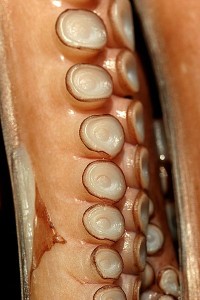
Octopus genes for chromatophore skin, suckers and the CNS are unique from the expansions listed above.
Human brain evolution was highly dependent on increased alternate RNA splicing (see post). In the octopus, brain development was highly dependent on the multiple effects of jumping genes and extensive editing of messenger RNA. Both produce many new unique proteins. The set of transcription factors and signaling pathways are similar in octopus and vertebrates.
Messenger RNA editing
Octopuses may have the most extreme RNA editing of any animal and therefore can rapidly create new proteins. This occurred throughout evolution, but recent research shows how they use it currently, for adaptation to temperature and great ocean depths. It is not clear why they have this unique genetic capacity.
The octopus doesn’t maintain one temperature, but has changing temperatures (poikilotherm). These changes alter neuron functions such as action potentials. With cool temperatures, both sodium and potassium channels slow down, but potassium more so. Near freezing, potassium channels open 14 times slower and close 60 times slower. With RNA editing (at locus I321V) the rate doubled for closing of potassium channels bringing the rates together.
Recently, another 100 editing sites were found in messenger RNAs that have dramatic effects on starvation, heat stress and learning. The very cold Antarctica octopus edited nine RNA sites that altered the amino acid structure of the potassium channel.
Octopus Innovations
Octopuses have hundreds of completely novel genes for camouflage and prehensile arms with suckers that feel, grasp and sense chemicals. Their arms completely regenerate. Octopus, also, have a unique jet propulsion system and camera like eyes. They, also, have three hearts. Circulation is based on copper not iron. When severed, an arm can still withdraw from danger. There are many genes that have not been seen before. Some are related to tasting with suckers and seeing color from their skin. Smart suckers can be regenerated including the entire arm.
Camouflage

Octopuses have photosensitive cells (opsins) in their skin that can determine colors of their close surroundings (similar to rhodopsin in the retina). In evolution it appears that one mollusc developed this protein in the skin and then later the octopus and other cephalopods adapted this to help with camouflage. These colors are used to determine camouflage, not the eye, which sees very accurately but not in color.
- Instantaneous camouflage is triggered by a complex efficient nervous system. In milliseconds, they alter sacs that hold different colored pigments called chromatophores. This changes their patterns and colors to adapt to different under sea environments. The sacs shrink and enlarge changing the overall color. They change the texture, color and shape of skin.
- Another camouflage mechanism involves irridophores that reflect light to create similarity to objects nearby.
- A third mechanism uses leucophores that provide a definite background using white cells.
- Another mechanism includes special muscles that make special textures that are, also, similar to the environment.
Camouflage is an important strategy for defense since they have no teeth, claws or shell. They developed camouflage to such an extent that they can survive in any situation.
Suckers
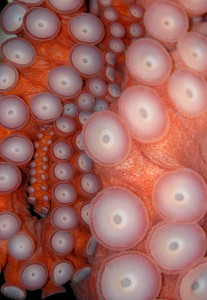
Suckers are quite independent. They move, sense (taste) and grasp independently, forming a very tight seal under water even on rough surfaces. Although soft as a jellyfish the attachment is incredibly strong using a cavity at the top with flexible sides making pressure. They have many grooves that are used to make a seal on rough irregular surfaces. The top is stiff (acetabular protuberance) while the sides and edges (infundibulum) are soft. Both stiff and elastic parts make a unique suction that becomes stiffer once contact is secure and with more pressure.
Severed Arms
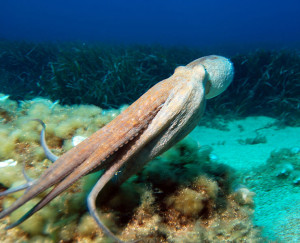
Arms do some cognitive work for the octopus. Even when severed they react. They use their arms by putting them in dangerous situations they cannot see, such as under rocks and in crevices, where they can encounter claws, teeth, sharps and chemical. They can stretch to twice the length (females three times). Arms are made from material like the human tongue that can bend and stretch with the same volume. The third left arm is the longest used most often for reaching. Third right arm delivers the sperm without much stretch.
Octopuses regrow arms, but unlike starfish, a severed arm doesn’t grow a new octopus. Somehow, acetylcholine signaling is involved in regrowth and when completed the arm is as good as the old one. At three days, a knob is formed with undifferentiated cells. Other signals trigger a hook at two weeks with blood vessels and many stem cells. By one month these features disappear and the new arm is finished in three months. Acetylcholine is in the nerves but not much in the arm until three weeks. A large amount appears as the new suckers and chromatophores are built. Gradually there is less acetylcholine after a month.
Complex Behavior
Octopuses exhibit very complex behavior, both individually and in groups. When angry, they gather up armfuls of debris and throw this at others using their jet propulsion siphons to propel the debris by directing the jet under its arms. Usually siphons are used for travel. They use the jet to clean their homes of sand and dirt, as well as intruding fish.
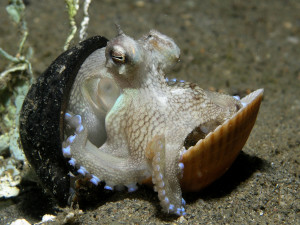
Previous research mainly found octopus as isolative. But, recently societies of crowded octopuses have been found. In this situation, some of them are cooperative and even kiss beak to beak (the only other creature than humans to do this are cuttlefish and squid). But, also fights break out. Boxing, as well as throwing, has been observed recently.
Octopuses have been observed moving toward a shrimp. With one arm tapping on its back, the shrimp rushes away into other octopus arms.
One species has been observed in groups up to forty. Mating in this group can occur by them living together for several days with no fighting. They can have rough sex grabbing each other sucker to sucker and kiss face to face.
In mating of some species, the male stretches out its special arm with sperm, which often breaks off and stays with the female. Sometimes the female then kills and eats the male. They usually only mate once. The social type mates many times over months. Many females stay with their eggs to such an extent that they can starve to death protecting them. Another species mate further while with the eggs.
When captured, octopuses adapt, but don’t like it if there isn’t enough activities. They are adept at opening twist off pill bottles, but, also, the more complex child proof. They can rapidly figure out advanced puzzles as do crows and primates.
The Uniquely Talented and Intelligent Octopus
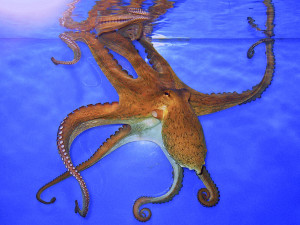
Octopuses have advanced intelligence and probably are the first very intelligent creatures on earth despite evolving separately from mammals, birds, insects and reptiles for 500 million years. They appeared before the first fish. Their intelligence does not appear to be related to complex social groups (as had been one of the many assumptions of the origin of intelligence in mammals.) In fact, four distinct evolutionary lines among mollusks, without vertebrae, independently developed central nervous systems.
The completely independent development of capacities is called convergent evolution. How can such completely different creatures all develop a central nervous system and high intelligence? It is often said that it was in competition with fish, amphibians and reptiles that octopus rapidly developed a complex large brain the size of a dog. How can this occur?
It cannot only be, only, from random mutations. How can any reasonable person think that this is an accident for the appearance of high intelligence in so many lines that developed from small non-intelligent creatures after five hundred million years of separate evolution?
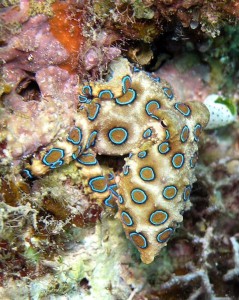
There are unique genetic events that occurred that stimulated rapid changes with many new proteins. In humans it was alternative RNA splicing (see post) and in the octopus it was adapting jumping genes and editing its own RNA. But, there has to be a path to higher intelligence and similar brain structures for all these to follow.
In humans pruning of synapses and neuroplasticity occurs with mental usage. Isn’t it reasonable to suppose that these processes are, also, related to the inherent mind of the creature searching for greater and greater capacities—the interaction of mind with the organism, with their cells, organelles, and molecules?
